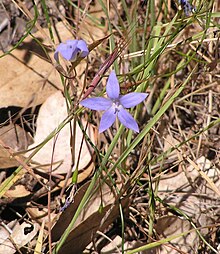Wahlenbergia stricta
| Wahlenbergia stricta | |
|---|---|

| |
| Scientific classification | |
| Kingdom: | Plantae |
| Clade: | Tracheophytes |
| Clade: | Angiosperms |
| Clade: | Eudicots |
| Clade: | Asterids |
| Order: | Asterales |
| Family: | Campanulaceae |
| Genus: | Wahlenbergia |
| Species: | W. stricta
|
| Binomial name | |
| Wahlenbergia stricta | |
Wahlenbergia stricta, the Australian bluebell, tall bluebell or austral bluebell, is an Australian wildflower from the Campanulaceae family.[1] It is considered the most commonly encountered of the Wahlenbergias.[1] It is found in all Australian states but not the Northern Territory. It is often seen growing by the side of the road, enjoying the extra runoff.
Wahlenbergia stricta is a perennial herb flowering mainly in spring or summer with pale blue bell-like flowers.[1] The leaves are long and linear, 5–70 millimetres (0.20–2.76 in) long.[1] The five-petalled flowers are erect on long, slender stems and about 6–20 millimetres (0.24–0.79 in) in diameter.[1] It forms thin, carrot shaped tubers.
Cultivation

Australian bluebells are generally easily propagated by division or root cutting. The seed is a very fine, black powder. It germinates readily in a few weeks and is best directly sown into tubes or cells as the seed and plant are very small and hard to separate and prick out.
There are a number of common cultivars, including various shades of blue from a saturated blue similar to #00f through to white. Various double forms are available. To maintain a cultivar propagation must be by vegetive means (division or cuttings).
Once established W. stricta is very hardy - the pot can be dried out completely and the plant reduced to a tuber, yet it will reshoot when the rain comes. It is hardy in a range of soils from sand to gravel, clay to humus.
See also
- Wahlenbergia gloriosa, although the gloriosa is the ACT flower, the stricta is more commonly seen and often misidentified as gloriosa.
References
- ^ a b c d e Walker, Karen; Burrows, Geoff; McMahon, Lynne (2001). 'Bidgee bush : an identification guide to common native plant species of the south western slopes of New South Wales. Yarralumla, Australian Capital Territory: Greening Australia. p. 98. ISBN 1-875345-61-2.
External links
![]() Media related to Wahlenbergia stricta at Wikimedia Commons
Media related to Wahlenbergia stricta at Wikimedia Commons
